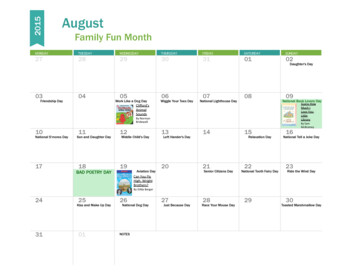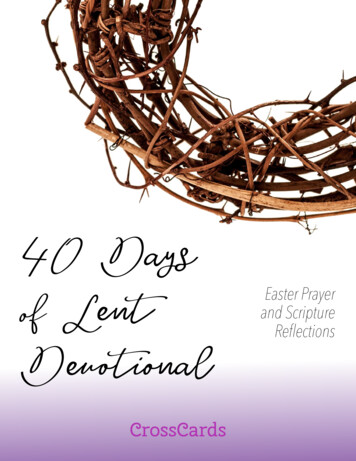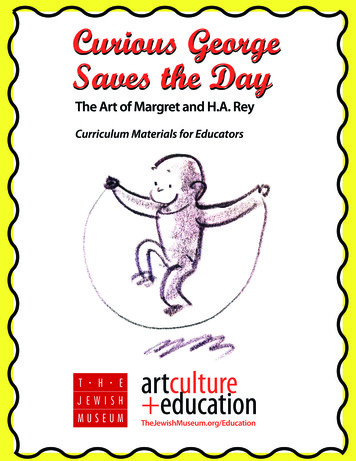
Transcription
Curious GeorgeSaves the DayThe Art of Margret and H.A. ReyCurriculum Materials for Educatorsartculture educationTheJewishMuseum.org/Education
INTRODUCTIONMargret and H.A. Rey’s children’s books about America’s beloved monkeyCurious George hold a special place in the hearts of both children and adultsaround the world. This resource for educators is designed to complementand enhance a classroom study of the Reys’ Curious George stories.Developed for educators to use with young children, the resource providesdiscussion questions, activities, and lessons for an in-depth study of selectedCurious George stories and may be adapted for various grade levels.These curriculum materials also provide insight into the lives of George’sremarkable creators.ACKNOWLDGEMENTSThis educator resource was written by Lisa Libicki, edited by MichaelynMitchell, and designed by JiaJia Fei. At The Jewish Museum, Greer Kudon,former Senior Manager of School Programs and Outreach, and Alyson Luck,School Outreach and Curriculum Resources Coordinator, facilitated theproject’s production. Special thanks to Nelly Silagy Benedek, Director ofEducation, and Claudia Nahson, Curator, for providing valuable input.These curriculum materials were inspired by an exhibition of nearly eightyoriginal drawings and preparatory dummies for the children’s books ofMargret and H.A. Rey on view at The Jewish Museum March 14 - August 1,2010. The exhibition Curious George Saves the Day: The Art of Margret andH.A. Rey is supported through a bequest from the Estate of Lore Ross. WNET.ORG is the media sponsor. This publication has been made possible by agrant from The Leona M. and Harry B. Helmsley Charitable Trust.Curious George Saves the Day: The Art of Margret and H. A. Reyis supported through a bequest from the Estate of Lore Ross.WNET.ORG is the media sponsor.Front cover: H. A. Rey, unpublished drawing, United States, c. 1950s-60s, pencil on paper.H. A. & Margret Rey Papers, de Grummond Children’s Literature Collection, McCain Libraryand Archives, The University of Southern Mississippi. Curious George, and related characters, created by Margret and H. A. Rey, are copyrighted and trademarked by HoughtonMifflin Harcourt Publishing Company. 2010 by HMH.1
The ReysThe character Curious George and the originalbathtubs as part of a family business. Margretseven illustrated books about his adventures—andRey immigrated there ten years afterward to findmisadventures—were created by the husband-work and escape the hostile political climate inand-wife team of Margret and H. A. Rey.Germany.Born Hans Augusto Reyersbach on September 16,Both Margret and H. A. Rey were German Jews.1898, in Hamburg, Germany, H. A. Rey becameAdolf Hitler’s rise to power and appointment asinterested in animals and drawing at an early age.chancellor of Germany in 1933 had created anGoing to both the zoo (he grew up near the world-increasingly dangerous environment for Jewsrenowned Hagenbeck Zoo) and the circus as aliving in that country. Margret relocated to Brazil,child, he had frequent exposure to the antics ofin part, to distance herself from this situation.live animals. H. A. Rey was also a self-taught artist.He was able to combine his interests in animalsMargret and H. A. Rey were married in Rio onand art early in his career when he landed a job asAugust 16, 1935. Margret persuaded H. A. Rey toa poster designer for a circus.leave the family business, and before long, thetwo were pursuing professional projects together,Margret was born Margarete Elisabeth Waldsteinincluding founding one of Rio’s first advertisingon May 16, 1906, also in Hamburg. She receivedagencies.formal art training at the esteemed BauhausSchool in Dessau and the Düsseldorf Art Academy.Though the character Curious George was stillMargret developed interests in photography andyears away from being created, the Reys werewriting and, later in life, pottery and needlepoint.accumulating experiences that probably servedShe worked in advertising and in photographicas inspiration for the monkey protagonist.studios in Germany and England during the lateWhile living in Rio, Margret and H. A. Rey had pet1920s through the early 1930s.marmosets, monkeys indigenous to Brazil.Additionally, H. A. Rey had opportunities to sketchMargret and H. A. Rey first met in Germany, asmonkeys in the Brazilian wildlife.family friends, when Margret was a young girl.They were to become much better acquaintedThe couple visited Paris in 1936 for their honeymoonyears later, in 1935, in Rio de Janeiro, Brazil. H. A.and decided to remain there, turning what was toRey had settled there in 1925 and was sellingbe a few weeks’ sojourn into a four-year residence.2
It was in Paris that the Reys began working ontemporarily to the Château Feuga, a castle inchildren’s books. A French publisher had spottedSouthern France owned by friends, to removeH. A. Rey’s newspaper cartoons of a giraffe andthemselves from the anxiety of living in the capital.encouraged him to use the character as theAfter an extended stay there, they returned to Parisprotagonist for a children’s book. This giraffebut then left for Avranches in Normandy, in thebecame the title character of Raffy and the 9spring of 1940. When they returned to Paris laterMonkeys (Cecily G. and the 9 Monkeys in thethat spring, it was with a plan to escape France forAmerican edition), published in 1939. This is thegood before the Nazis took power there.book in which Curious George (the youngest ofthe nine monkeys and then known as Fifi) makesThe Reys’ preoccupation with journeyinghis debut. After Raffy and the 9 Monkeys waselsewhere to escape their situation certainly foundpublished, the Reys decided they would makeits way into the Curious George narrative, as wellCurious George the protagonist of their next book.as into the other stories they were working onduring this time period.In all, the Reys published seven books duringtheir years in Paris and also completed theThe couple decided they would relocate to Newmanuscripts and drawings for at least four otherYork City, as Margret’s sister was living near thebooks that would later be published in America,city at the time. After working hard to secure allincluding Curious George.the necessary paperwork and plan their route ofdeparture from Europe, the couple foundThe Curious George books were a truethemselves unable to leave Paris via train.collaboration between Margret and H. A. Rey.They decided their only option was to leave onTheir creative process was complex, but for thebicycle, but the only bicycle they could procuremost part, H. A. Rey was in charge of illustrationswas a tandem. After practicing on the tandem,and the overall idea for the story while Margrethowever, they realized this was not going to be adeveloped the plot and wrote the text.viable option for them. They returned the bike andexchanged it for spare bicycle parts that H. A. ReyDuring the time the Reys were working on the firstused to cobbled together two individual bicycles.Curious George book, the political situation inEurope was rapidly deteriorating. In 1939,Early on the morning of June 12, 1940, the ReysGermany invaded Poland, marking the start ofleft Paris for good on their makeshift bikes.World War II. France declared war on GermanyIncluded in the very little baggage they took withwithin days, and soon the Reys felt the warthem were several manuscripts. While the originallooming heavily over them. The couple movedmanuscript and perhaps sample illustrations for3
Curious George had already been sent off safelypublisher and also fled war-torn Europe, hadto America for prospective publication, the Reyssecured a position at Houghton Mifflin.)carried with them the final artwork for theillustrations.Over the next twenty-five years, the Reys wrotesix more Curious George stories.The Reys’ escape was a narrow one: The Nazisentered Paris just two days after the couple hadThe Reys were also prolific beyond the Curiousfled on their bicycles.George series. In total, the husband-and-wife teamauthored and illustrated more than thirty books,The couple rode their bicycles for three longmost of them for children. They each weredays, later boarding a train to reach the French-involved with a variety of other creativeSpanish border. Along the way, they bedded at aprofessional pursuits as well, including lessfarmhouse, in cow stables, and on the floor of acollaborative, more independent projects.restaurant.H. A. Rey passed away in 1977, and Margret ReyFrom the French-Spanish border, the Reys weredied in 1996, but their legacy is alive and well.able to travel by train across Spain and thenWith translations in more than fifteen languages,through Portugal to Lisbon. From there, theyCurious George is today enjoyed by childrenmade their way to Brazil by boat and then, aaround the world.couple of months later, on to New York City, alsoby boat.Please note:Although all seven Curious George books wereFour months after leaving Paris, the Reys settledco-created by Margret and H. A. Rey, Margret’sin New York’s Greenwich Village, making it theirauthorship is only acknowledged on the finalhome for the next twenty-three years. They thenthree books.moved to Cambridge, Massachusetts, where theyresided for the rest of their lives.As Margret Rey once explained, “When we firstcame to America, our publisher suggested we useCurious George was published by the Americanmy husband’s name because the children’s bookpublisher Houghton Mifflin in 1941, a year afterfield was so dominated by women. They thoughtthe Reys’ arrival in the United States. (This quickit would sell better. After a time, I thought, ‘Whytimetable was due, in part, to the fact that Gracethe devil did I do that?’ so since then my nameHogarth, who had worked for the Reys’ Britishhas appeared also.“4
Margret and H.A. Reyat a book signing,United States, c. 1945This photograph features the Reys, both ofthem mugging and posing for the camera.Margret sits at a desk, pausing betweenautographing books, while H. A. Rey is caughtmid-drawing—simultaneously sketchingwith both hands! He is drawing on achalkboard that is white with erasures.He may have been drawing for the childrenin an almost performative way—drawing,DISCUSSION QUESTIONSWho do you see in this photograph?At what type of event might thisphotograph have been taken?How can you tell?What can you tell about the mood at thisevent from the facial expressions ofMargret and H. A. Rey and the children?What do you notice about the wayH. A. Rey is drawing?Why might the photographer have chosento capture Margret at the desk anderasing, and then drawing anew so thechildren can observe the artistic process.The kangaroos on the board arereminiscent of the kangaroos from the zooin the original Curious George tale; those inthe animal show in Curious George Rides aBike; and even the kangaroo protagonist ofKaty no-Pocket (1944), a book illustrated byH. A. Rey and written by Emmy Payne. Herethere are two sets of mothers and joeys,facing each other, as if mirror images ofone another.H. A. Rey at the chalkboard?Margret and H. A. Rey at a book signing, United States, c. 1945. H. A. & Margret Rey Papers, de Grummond Children’s Literature Collection,McCain Library and Archives, The University of Southern Mississippi.5
Découpages à colorer (unpublished), Paris, c. 1938This image, drawn in pen, ink, color pencil andDISCUSSION QUESTIONScrayon on paper, features a man and a womanriding a tandem bicycle. It is one of H. A. Rey’sWhat art materials does it look likecutouts from La Rue: Découpages à colorer, aH. A. Rey used to create this artwork?never-published French-language book. Attired inWhat shapes do you see in this artwork?matching outfits, the couple in this illustration bearsWhat do you notice about the riders’some resemblance to Margret and H. A. Rey at theclothes?time the picture was drawn in the late 1930s.Coincidentally, this tandem bicycle image predatesan important instance in the Reys’ personal historythat involved a tandem bike. When the Reys fledParis in 1940, they originally procured a tandem biketo ride out of town. They had so much trouble ridingit that H. A. Rey went back to the bicycle shop andexchanged the tandem for spare parts that he usedto cobble together two separate bikes.H. A. Rey, découpage for La Rue: Découpages à colorer (unpublished), Paris, c. 1938, pen and ink, color pencil, and crayon on paper. H. A. &Margret Rey Papers, de Grummond Children’s Literature Collection, McCain Library and Archives, The University of Southern Mississippi.6
Découpages à colorer (unpublished), Paris, c. 1938This is an illustration of a hotel, also from La Rue:While by no means a faithful rendering of theDécoupages à colorer. The architecture includesTerrass Hotel, where the Reys lived for four yearsarched doorways on the ground floor,in Paris—from 1936 to mid-1940 (the samerectangular windows with shutters on the secondperiod during which this image was drawn)—floor, and dormer windows projecting out of athis illustration could very well have beensloped roof on the top floor. There are severalinspired by the hotel. The Reys intended to staycharacters in the composition: a female lottery-at the hotel for a few weeks at the end of theirticket vendor at the lower left; a bartender at thehoneymoon, but they ended up staying therelower right; and a man in one of the top-floorfor much longer. This was possible because thewindows. With his glasses and pipe, this manfamily-owned Terrass’s Hotel, built in 1912, hadbears a striking resemblance to the artist andboth traditionalhotel rooms and apartmentmay in fact be a self-portrait of H. A. Rey.residences.H. A. Rey, découpage for La Rue: Découpages à colorer (unpublished), Paris, c. 1938, pen and ink, color pencil, and crayon on paper. H. A. &Margret Rey Papers, de Grummond Children’s Literature Collection, McCain Library and Archives, The University of Southern Mississippi.7
The Reys made the hotel their home for four years(with the exception of an extended stay in the southof France and another in the north).Certain features of the architecture in the illustrationare reminiscent of the Terrass’s design, including thearched openings on the ground floor.The Terrass Hotel was commandeered by the Nazisin June 1940 (shortly after the Reys had fled Paris)and occupied by them until August of 1944.The hotel is still in operation today.H. A. Rey, découpage for La Rue: Découpages à colorer (unpublished),Paris, c. 1938, pen and ink, color pencil, and crayon on paper. H. A. &Margret Rey Papers, de Grummond Children’s Literature Collection,McCain Library and Archives, The University of Southern Mississippi.DISCUSSION QUESTIONSDescribe the various features of the building.Describe the different characters and theirgestures.How many animals do you see in thepicture?How is this building similar to or differentfrom those in your own neighborhood?8
Lessons and ActivitiesTHE SYMBOLISM OF A BICYCLEB U I LT F O R T W ODiscuss with your students what a symbolis. In addition to discussing the definition,explore examples of symbols that relate tobooks you have read in class.Discuss how a tandem bike might functionas a symbol. How might this symbolismIT’S ALL ABOUT TEAMWORK!relate to the Curious George books?Riding a tandem bicycle requires teamwork.Even though the Reys were not able to successfullyBoth riders need to pedal and maintainride a tandem bicycle, the tandem bike is an aptbalance in order to move forward. And theysymbol for their creative collaboration on theneed to agree on when to start and stop.Curious George books. A tandem bike can alsofunction as a symbol for the “teamwork” requiredAs a class, create a word web diagramof the text and illustrations to work together to tellof the word teamwork on the board.the Curious George tales.Encourage your students to thinkabout all the ideas and experiencesAsk your students to think of other objectsthey associate with teamwork.that could be symbols of teamwork. Havethem make drawings or collages of theseUsing ideas generated from this wordobjects.web or elsewhere, ask your students towrite about and/or illustrate anAlternatively or in addition to exploring theoccasion when they have relied onnotion of teamwork, you might ask yourteamwork.students to create symbols for other classroom or community values that you havepreviously discussed.H. A. Rey, découpage for La Rue: Découpages à colorer (unpublished), Paris, c. 1938, pen and ink, color pencil, and crayon on paper. H. A. &Margret Rey Papers, de Grummond Children’s Literature Collection, McCain Library and Archives, The University of Southern Mississippi.9
How was Curious George Created?FIFI THE MONKEYFifi the monkey, later renamed Curious George,Instead, the manuscript was sent to a publishingmade his first appearance in the Reys’ firstagent in the United States in the early spring ofchildren’s book, originally titled Raffy and the1940, with the final illustrations only making their9 Monkeys (1939). The main character, a lonelyway to the states when the Reys arrived with themgiraffe, befriends nine monkeys who becomein the fall of that year.her playmates. Fifi is the youngest of her monkeyfriends.French and British audiences were thus introducedto Fifi in 1939 when Raffy and the 9 Monkeys wasThe Reys set about writing this book and thusfirst published in those countries. However, sinceentering the world of children’s literature at theCurious George’s 1941 publication in the Unitedencouragement of a French editor named JacquesStates preceded that of the retitled Cecily G. andSchiffrin. Schiffrin, who worked for the famousthe 9 Monkeys, when American audiences werepublishing house in Paris called Gallimard, hadfirst introduced to George, he was already a mainseen H. A. Rey’s cartoons of a giraffe in a Parischaracter of his own tale.periodical and suggested that the Reys turn thegiraffe into a children’s story character. It was uponIn spite of H. A. Rey’s frequent exposure to liveRaffy’s publication that the Reys decided that Fifimonkeys—at the zoo, at the circus, in the wild,deserved his own picture book, and they startedand as pets—there is one particularly notablework on it in 1939. Curious George was likely inabsence in the rendering of George and the otherprocess by the time the Reys reached Châteaueight monkeys in Raffy: They have no tails! WhenFeuga, and H. A. Rey finished the illustrations afterquestioned about the artistic license he took, H. A.the couple returned to Paris in January 1940.Rey replied that his monkey characters are a crossbetween a gibbon and an ape, adding that whenWhile the Reys’ editor in England expressed greathe first drew the story of Raffy, “the giraffe’s longinterest in publishing Fifi: The Adventures of aneck and legs plus tails of all nine little monkeysMonkey in 1940, the impending Nazi bombing ofmade the drawings look like spaghetti!”Britain and new restrictions on the importation ofbooks from France made that an impossibility.10
W H AT H A P P E N E D T O G E O R G E W H E N T H E R E Y S A R R I V E D I NN E W YO R K C I T Y ? H O W WA S H E T R A N S F O R M E D ?Before publication in the United States, FifiThe fact that Margret Rey is not cited as anunderwent several transformations, first andauthor until publication of Curious George Flies aforemost, getting a new name that would appealKite, the fifth Curious George book (published into an American audience: Curious George.1958), is a direct consequence of the books beingpublished in the United States. In the early 1940s,Back in France, H. A. Rey had created colormost children’s books were created by women.illustrations (in watercolor) for Curious George.The Reys’ American publisher thought that re-Many American publishers at the time, however,leasing their books under H. A. Rey’s name onlyrequired their illustrators to submit pre-separatedwould help promotion and increase sales sinceartwork for their books in an effort to keephaving a male author was more unusual.printing costs down. This meant that for eachillustration the artist had to create a drawing forThe Reys’ immigration to the United States alsoeach of the four colors of ink used in color printinghad an impact on Curious George storylines. In(black, blue, red, and yellow). Printer’s plates werethe last six Curious George books, George oftenthen created from these separations. When printedgets to live out archetypal “American dream”on the same page, the colors overlap and blend tofantasies: he lands an acting job in Hollywood,create the desired colors. In keeping with thisadvances scientific research by traveling in apractice, H. A. Rey was asked to create separationsspaceship, and gets his fifteen minutes of famefor Curious George, meaning that his originalon the front page of many newspapers.watercolors were not used in the 1941 edition.While recreating the Curious George illustrations,Rey adapted his style to the American publishingpractice of requiring pre-separated artwork, theresult being less painterly, more linear images.It was only in 1998 that Houghton Mifflinpublished The Original Curious George with H. A.Rey’s original watercolors.11
THE ORIGINAL CURIOUS GEORGE STORYThis is how readers are introduced to the titleescapes from jail; and he escapes his predicamentcharacter in the first Curious George book:of being carried off by a bundle of balloons. Whilethis book was written before the Reys escapedThis is George.from war-torn Europe, it is likely that the theme ofHe lived in Africa.escape was already very much on their minds.He was a good little monkeyand always very curious.The concept of “saving the day,” however, onlyappears in the later Curious George books, thoseThese lines reveal the main character’s name,written and illustrated by the Reys after their safewhere he is from, and his most prominent traits.arrival in America. This concept seems to haveThe illustration on the facing page provides thedeveloped directly from the important role thatfirst image of George and his nearly constant smile.the character had played in saving the Reys’ liveswhen fleeing Nazi Europe. Twice in 1939–40,Throughout the tale, the text and illustrations workduring the early war years, the Reys raised thetogether to tell the story. Sometimes they reinforcesuspicions of local authorities—once at Châteaueach other; sometimes the illustrations show whatFeuga and once at the French-Spanish border.is not told; and sometimes the writing revealsWhen illustrations for their children’s books wereinformation that cannot be easily communicatedfound among their possessions, the Reys werethrough images.cleared of these suspicions. Their artwork alsoprovided proof of their occupations when it wasTogether, the words and images tell the story oftime to obtain American visas. Furthermore, thea monkey taken from Africa by a man with apopular and financial success of the Curious Georgeyellow hat to a new homeland across the sea.books helped the Reys rebuild their careers andAfter spending some time at the house of the manestablish themselves in this country.with the yellow hat and then some time in jail,George finally finds a new home at the zoo.Many who knew or have researched CuriousOf course, there are adventures and mishapsGeorge’s creators point out somealong the way, mostly thanks to George’sautobiographical aspects of the main characters inceaseless curiosity, but ultimately, George findsthe books. The man with the yellow hat exploreshimself happy in his new home.the jungles of Africa, which is not unlike H. A. Rey,who probably explored the jungles of Brazil whileIn this first Curious George tale, the monkey’straveling up and down the Amazon selling goods.narrow escape from danger is already a recurrentGeorge’s spunk and curiosity are traits oftentheme—he is saved from near drowning; heattributed to Margret Rey.12
George climbed upuntil he was in thesunshine again, highabove the rain cloud.In this illustration from Raffy and the 9 Monkeys,we see George clinging onto Raffy’s long neck.Unlike his siblings and mother below, George hasescaped the rain by riding aloft his giraffe friend’slong neck, high above the rain cloud. Hecelebrates his escape from the bad weather witha triumphant gesture. The eight monkeys belowshield themselves with umbrellas as they run forcover. Several of the other monkeys’ faces areDISCUSSION QUESTIONSvisible from beneath their umbrellas: one looksdispleased; one is smiling; and one, who seemsWhat animals do you see in this picture?to have spotted George above, responds with hisWhat is the total number of figures youmouth agape. Not only is it raining, but since thesee?rain is falling at a diagonal, it must also be windy.Describe the expressions on the differentThe dominant colors in the composition are thecharacters’ faces. Try to imitate theirorange of Raffy’s spots and the blue fur of theexpressions.monkeys. These colors are complementary,How does the artist show that theopposite one another on the color wheel,monkeys with umbrellas are running?creating strong color contrasts in the picture.H. A. Rey, final illustration for “George climbed up until he was in the sunshine again, high above the rain cloud,” Raffy and the 9 Monkeys(1939), later published as Cecily G. and the 9 Monkeys (1942), Paris, 1939, watercolor on paper. H. A. & Margret Rey Papers, de GrummondChildren’s Literature Collection, McCain Library and Archives, The University of Southern Mississippi. Curious George, and related characters,created by Margret and H. A. Rey, are copyrighted and trademarked by Houghton Mifflin Harcourt Publishing Company. 2010 by HMH.13
One Day Georgesaw a man.He had a largeyellow straw hat.DISCUSSION QUESTIONSWhat is similar about these two pictures?What is different?Why might H. A. Rey have decided to includethese two pictures on one page in thepublished book?This page includes two images that illustrate aHow is using two images together like thissingle page of text in the published book. Thesimilar to a comic strip? How is it different?two images take on an almost comic-strip quality,Describe the setting in these two illustrations.showing a succession of moments. The first imageDescribe the types of lines the artist uses inshows the first encounter between the man in thethese pictures. How many different types ofyellow hat and George. The man looks off in thelines do you see?distance, using his binoculars to check out George.How does the artist show that George is veryHe also has a camera and a rifle as accessories.far away in the first picture?George is swinging from a vine, repeating theDescribe the poses of the man and George.motif from the previous illustration in the book inCan you recreate them?which the reader first meets George. In the secondNotice how the pictures have irregularimage, H. A. Rey has zoomed in on the landscapeborders. Why might the artist have madea bit. George has approached the yellow hat withthis choice?an interested expression. For emphasis, the hat liesThink about what might happen next in thisoutside the irregular border of the image. The mannarrative. If there were a third image includedcrouches behind a tree, looking on with a grin.here, what would it depict?H. A. Rey, final illustration for “One day George saw a man. He had on a large yellow straw hat,” published in The Original Curious George(1998), France, 1939–40, watercolor, charcoal, and color pencil on paper. H. A. & Margret Rey Papers, de Grummond Children’s LiteratureCollection, McCain Library and Archives, The University of Southern Mississippi. Curious George, and related characters, created byMargret and H. A. Rey, are copyrighted and trademarked by Houghton Mifflin Harcourt Publishing Company. 2010 by HMH.14
George and the HatPlease refer to the title page in the publishedversion of the Curious George book.This is the title page of the Curious George book.It communicates the book’s title, the author andillustrator’s name, and information about thepublisher, all in hand-lettered text. Readers alsoget a peak at the illustrated story that will unfoldinside the book. Near the center of the page, thereader sees George approaching the yellow hatwith curiosity. Interestingly, this illustration isnot identical to the one it resembles within thestory itself. In this one, the shadows are morepronounced, giving the image more contrast, andmany subtle details have changed: George’s toes,the contour of his belly, the shape of his face, andeven the prominence of the tufts of grass.DISCUSSION QUESTIONSThis is the title page of the Curious Georgebook. Why do you think this image waschosen for the title page? Do you think itwas a good choice? Why or why not?Describe George’s expression.What do you think George is about to do?Many young readers do not yet know howto read cursive. Why do you think cursivewas used on the title page?15
This is Geroge.He lived in Africa.This is the first image associated with the CuriousGeorge story. In the published book, the relatedtext on the facing page occupies a fraction of thepage while this image nearly fills its page.H. A. Rey’s handling of the line quality is very fluid.The various elements of the setting—the trunk,branch, tufts of foliage, and band of pale blue skybelow George—frame the composition. The lowerleft to upper right diagonal of the tree branchsupporting the swing is echoed by the diagonalband of blue sky below George and again in thediagonal orientation of the butterfly’s wingspan.DISCUSSION QUESTIONSIn what ways does George look like a realmonkey? In what ways does he not looklike a real monkey?Using facial expressions, describe all theThe charcoal H. A. Rey uses for the linear elementsof the image gives texture to the drawing. Artistsoften repeat forms in an image to keep theviewer’s eye moving. Here, the shape of thebanana echoes the shape of George’s feet and, t
Curious George is today enjoyed by children around the world. Please note: Although all seven Curious George books were co-created by Margret and H. A. Rey, Margret's authorship is only acknowledged on the final three books. As Margret Rey once explained, "When we first came to America, our publisher suggested we use


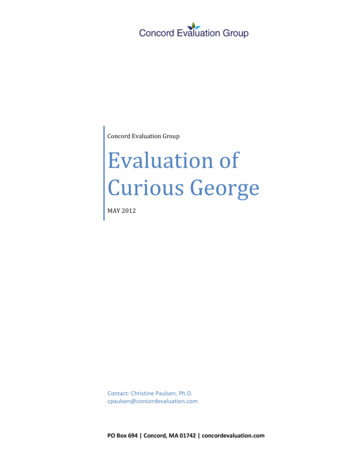
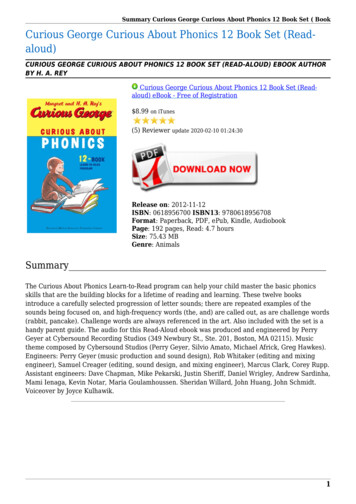

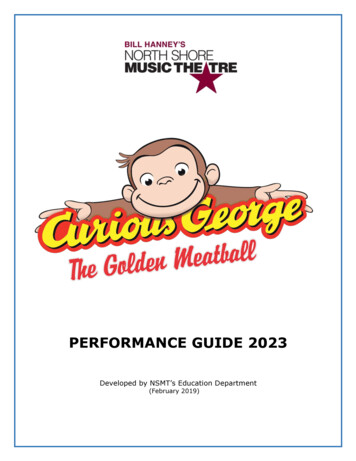
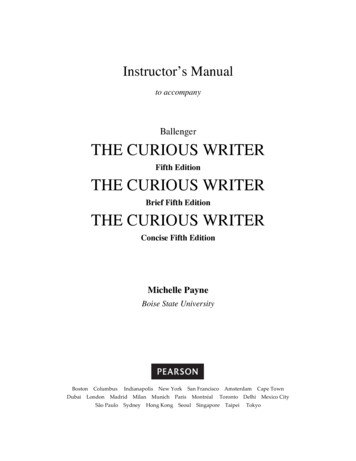
![Welcome [dashdiet.me]](/img/17/30-day-weight-loss-journal.jpg)
